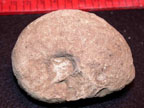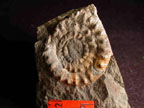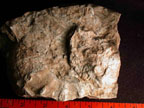Search and Rescue Report |
5/22/05 to 5/27/05 |
| The NARG by Mike Kelly - I have been assimilated. Resistance was futile. All they had to do was lead me to great ammonite localities and feed me their (cooked) food. With Andrew's locality research and Bill's skills with landowner protocols, it felt like having a backstage pass to the best concert ever. It was like being backstage at a concert where they let you collect the instruments and serve you spaghetti with sausages in it (and let you borrow a fork to eat it with).
I've always been afraid of landowners -- probably because if I owned land I'd be a mean landowner and you'd never even get past the barricades. So I feel ashamed to have just learned that there are actually friendly people out there owning some land. One landowner let us collect some of the prettiest little ammonites I've seen from Oregon, and another one let us collect my first ever display-quality Jurassic ammonites. I wish the Mike and Greg collecting club could have shared some new productive sites with the NARG. Apparently, the first site we collected was already known to NARG folk. Greg had found a nice Turrilites-type of heteromorphic ammonite there about three years ago, and this area has produced fragments of other heteromorphs for us -- more kinds of heteromorphs than any other area in that formation. The site lived up to its reputation and produced a nice heteromorph section for Bill, and my first Bacculites from that area, and crabs too! And I think everyone also found a few "regular" ammonites. The next morning we went to the private ranch. The little Leconteites-type ammonites were abundant in places. Some of them were preserved very nicely with shiny orange shell material, and nice calcite chambers. We found quite a few just laying out -- prepped by nature and ready to display. We found a couple of other ammonites and a large Pinna-type bivalve, which we have never found elsewhere in this formation. (Someone is going to have to help me with the ammonite IDs.) It was the kind of collecting where you get a little jolt of pleasure every couple of minutes, and occasionally several jolts in rapid succession. (I am not a pervert. I just happen to like easy ammonites very much.) In the afternoon Greg and I tried to turn the NARG on to our special pit-site. There were already several pits and broken ammonite hunks when Greg and I found the site about four years ago. At that time, we expanded one of the pits and uncovered a layer containing large (up to 10-inch) Leconteites-type ammonites and a few Douvilleiceras and other ammonites. We are pretty sure that starting another pit in the right place would uncover more, but our test digs were blanks this time. So it didn't take long before the memory of many easy little jolts of pleasure lured us back to the private ranch. Of course, the reason the NARG and the Greg and Mike club met there was to observe/help with the plesiosaur excavation. The pros did a great job, and a few of us hangers-on even got in there to take down a few layers of rock. The BLM seemed pretty enthusiastic about getting some publicity/education out of this find. They had a videographer on site the whole time, and BLM/Park Service dignitaries even stopped by for a dog-and-pony show. There were probably 20 people there at one point. The video guy had Greg and I demonstrate our "plesiosaur-finding" technique for the camera, and he interviewed us. (I wore a NARG hat.) Anyway, it was a fun 15-minutes-of-fame event for us. The pros came away with a plaster cast apparently containing the lower jaw of a plesiosaur that was previously unknown from the western states. Dr. Martin seemed very excited about the find -- says he spent 15 years searching the area for one of these critters. I don't recall all the details of why he thought it was such an important find, but I'm sure we can post whatever he writes up about it. Then Andrew, Bill and I took off for the Oregon Jurassic. A little landowner protocol got us access, a camping site with pre-stacked firewood and, most importantly, a picture-postcard outhouse. Here's something I bet you didn't know. You can keep cows from crossing a too-shallow cattle guard by covering it with a few sheep hides. When we first drove up I thought there was a dead sheep with its legs still stuck in the cattle guard, like nobody could be bothered to extract it. The landowner explained. He had three hides on the guard. (One had folded up to look like it was still a whole sheep.) This was on the public highway, and I think it freaked out a few passing motorists. Being a Cretaceous snob, I don't know what any of the Jurassic ammonites are. But they sure are cool. The big ridgy ones seemed mostly to be just the living chambers. I've read that sometimes the phragmocone (chambered whorls) is crushed/obliterated while the living chamber is preserved. I think it is because the open living chamber fills with sediment and resists crushing, while the hollow chambers crush under pressure. There's probably a name for this kind of preservation -- if not, I propose that we call it NARGification. Anyway, we eventually found a few very nice bigger ones with intact phragmocones, as well as several well-preserved smaller specimens. We also found a couple of nautiloids, belemnite tests, a couple of different clams, a Pecten-looking scallop, at least three kinds of brachiopods, and an ichthyosaur! With the ichthyosaur, Andrew and I weren't sure of what we had uncovered -- coulda been a piece of wood or a big bivalve hinge or whatever. When I tooth-brushed the soil and roots off of it later, it looked very much like some kind of rostrum. Andrew had said that an isolated ichthyosaur vertebra had been found in that area before, so I Googled "ichthyosaur." I was convinced in 0.10 seconds. I think more of the fossil is still there. The ~12 cm rostrum segment was under a concretionary knob sticking up through the soil, and it seems like it was attached to a bedrock layer under the soil. The remaining bone is very solid -- no flaking or loose bits. I wrote a letter to the landowner asking if we can notify researchers about the location. There is a researcher at UC Davis who would be interested. Apparently, identifiable ichthyosaurs from the Middle Jurassic are very rare -- I think only one from about a 15-million-year span. I also contacted Dr. Martin, and he knows some folks who would be interested. So, if the landowner agrees, maybe we can go "help" with another dig. I'll keep folks posted as I hear anything. What a trip by Andrew Bland - The primary goal of this trip was to assist in the recovery of a short neck plesiosaur discovered last year by Mike Kelly in the cretaceous Hudspeth formation. John Zancanella from the Prineville BLM office setup recovery effort with Dr. James Martin from the South Dakota School of Mines and Technology as the onsite paleontologist. This could be a very long report to cover everything so I'll trim it down. It took 3 days to recover the lower jaw portions of the plesiosaur skull with Dr. Martin, Jennifer, and John Z. doing primarily most of the work and John Craig doing all the film work and subsequent story to be provided to the AP for distribution. When we weren't standing around gawking and asking interrupting questions we where out collecting ammonites from various locations. Bill found a very nice specimen of Eurocrystes crab as well as a good portion to a heteromorph ammonite. I found the best specimen yet of a Lecontities ammonite as well as a yet to be ID'd crab. The plesiosaur was cast and loaded into John's truck to be taken back to South Dakota for preparation. We said our fair well and sent out best wishes then Mike, Bill and I headed to the southeast to collecting areas around Suplee, Izee, and Weberg for Jurassic (Bajocian) ammonites from the Snowshoe formation. Most of the land is private in this area so make sure you get permission before you do any collecting. The first evenings collecting was great and Mike found a ridge that produced numerous large ammonite fragments. Not many complete ones are found but they are big. The next day we didn't fair as well but toward the evening we I got onto another ridge that produced several ammonites at least 75% complete. The next morning Mike and I headed to a new site where he found the rostrum to an ichthyosaur. Some guys have all the luck and it looks like another trip is in order. Paleontologists: BLM: Mike Kelly: Plesiosaur discoverer
NARG Members: Andrew Bland, Steven Bland, Mike Schlabach, Jerry Rawdon, Bill Sullivan |
| ©2004 NARG - North America Research Group |










